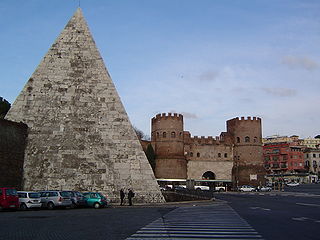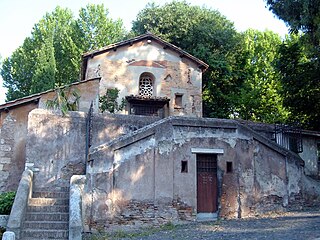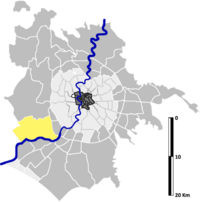
The city of Rome, Italy, is divided into first-level administrative subdivisions.

Testaccio is the 20th rione of Rome, Italy, identified by the initials R. XX, deriving its name from Monte Testaccio. It is located within the Municipio I. Its coat of arms depicts an amphora, referencing to the broken vessels that Monte Testaccio is made of.

Parioli is the 2nd quartiere of Rome, identified by the initials Q. II.

Prima Porta is the 58th zona of Rome, identified by the initials Z. LVIII. The name Prima Porta came from an arch of the aqueduct that brought water to the Villa of Livia, which formed over Via Flaminia a sort of gateway which travellers saw as the first indication of having reached Rome (Piperno).

Ostia Antica is the 35th zona of Rome, Italy, four kilometers away from the coast. It is identified by the initials Z. XXXV and it is distinct from Ostia. Ostia Antica belongs to Municipio X.

Torrenova is the 16th zona of Rome, identified by the initials Z. XVI. It belongs partly to the Municipio VI and partly to the Municipio VII.

Labaro is the 57th zona of Rome, identified by the initials Z. LVII. It is located 11 kilometres north of the city center, along the Via Flaminia, just outside the Grande Raccordo Anulare.

Cesano is the 52nd zona of Rome, Italy, identified by the initials Z. LII. It takes its name from the small medieval village of Cesano di Roma, on the Via Cassia, which is located within the Municipio XV, 27 km from Rome proper.

Settecamini is the 6th zona of Rome, identified by the initials Z. VI.. Settecamini is also the name of the urban zone 5L, within the Municipio V of Rome.

Via Cristoforo Colombo is a street in Rome (Italy) that links the historic centre to Ostia. Along most of its route, the street has three lanes for each direction of movement. With its 27 kilometres (17 mi) length it is the longest Italian road among those included within the borders of a single municipality and, in several stretches, the largest in Italy.
Colle Salario is a frazione of the Municipality of Rome (Italy), located in the zone Z. II Castel Giubileo, within the territory of the urban zone 4E Serpentara of the Municipio Roma III.

Val Melaina is the 1st zona of Rome, identified by the initials Z. I, lying north of the city centre and covering an area of 6.2447 km².

Portuense is the 11th quartiere of Rome (Italy), identified by the initials Q.XI.

Giuliano-Dalmata is the 31st quartiere of Rome, identified by the initials Q. XXXI. Its name refers to the Julian, Istrian and Dalmatian refugees that settled there in the postwar period.

Ponte della Magliana is a motorway bridge in Rome (Italy). It crosses the Tiber between Pian due Torri and Via del Cappellaccio, linking the Quartieri Portuense and Ostiense, respectively, on the right and on the left of the river.
Massimina is the urban zone 16E of Municipio XII of Rome. In a separate subdivision scheme, it belongs to zone "O" 20 A-B. Massimina is included in zone XLV Castel di Guido.

The Rome–Fiumicino railway is an urban railway line in Rome.

Tor Cervara is the 7th zona of the Italian capital Rome, identified by the initials Z. VII. It belongs to the Municipio IV and has 13,975 inhabitants (2016). It is located in the east of the city, within the Grande Raccordo Anulare, and has an area of 5.9000 km2.

Castel Giubileo is the second Zone of Rome in the Ager Romanus, identified as Z. II.
Piana del Sole is a frazione of Rome, located in zone Z. XLIPonte Galeria, in the territory of Municipio XI.


















